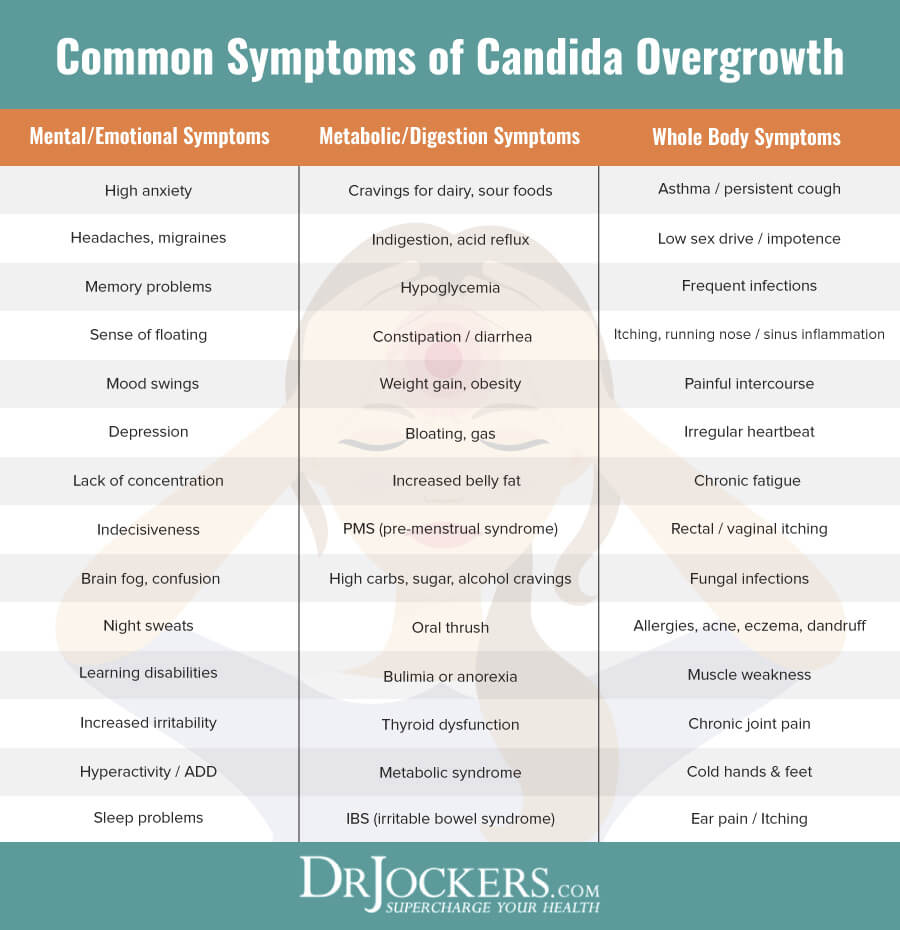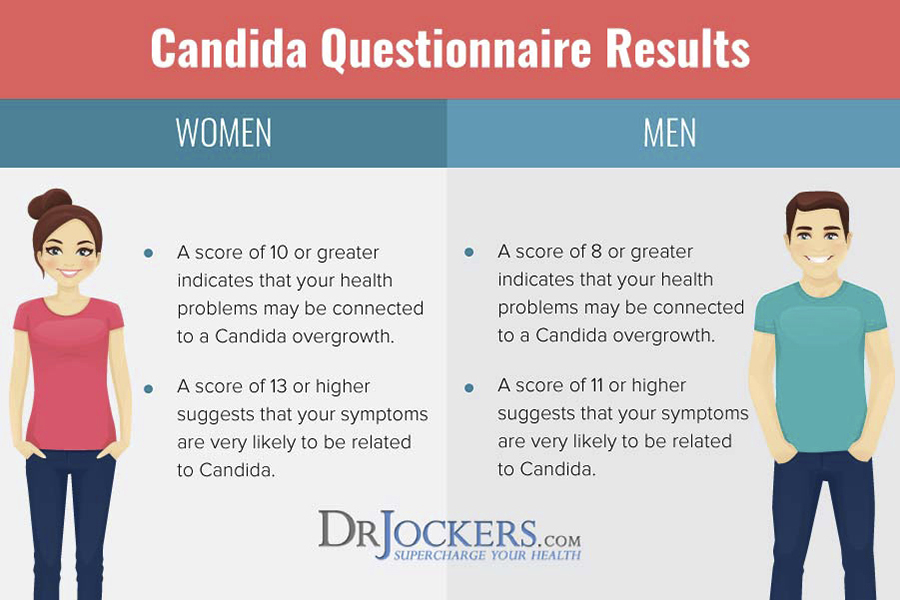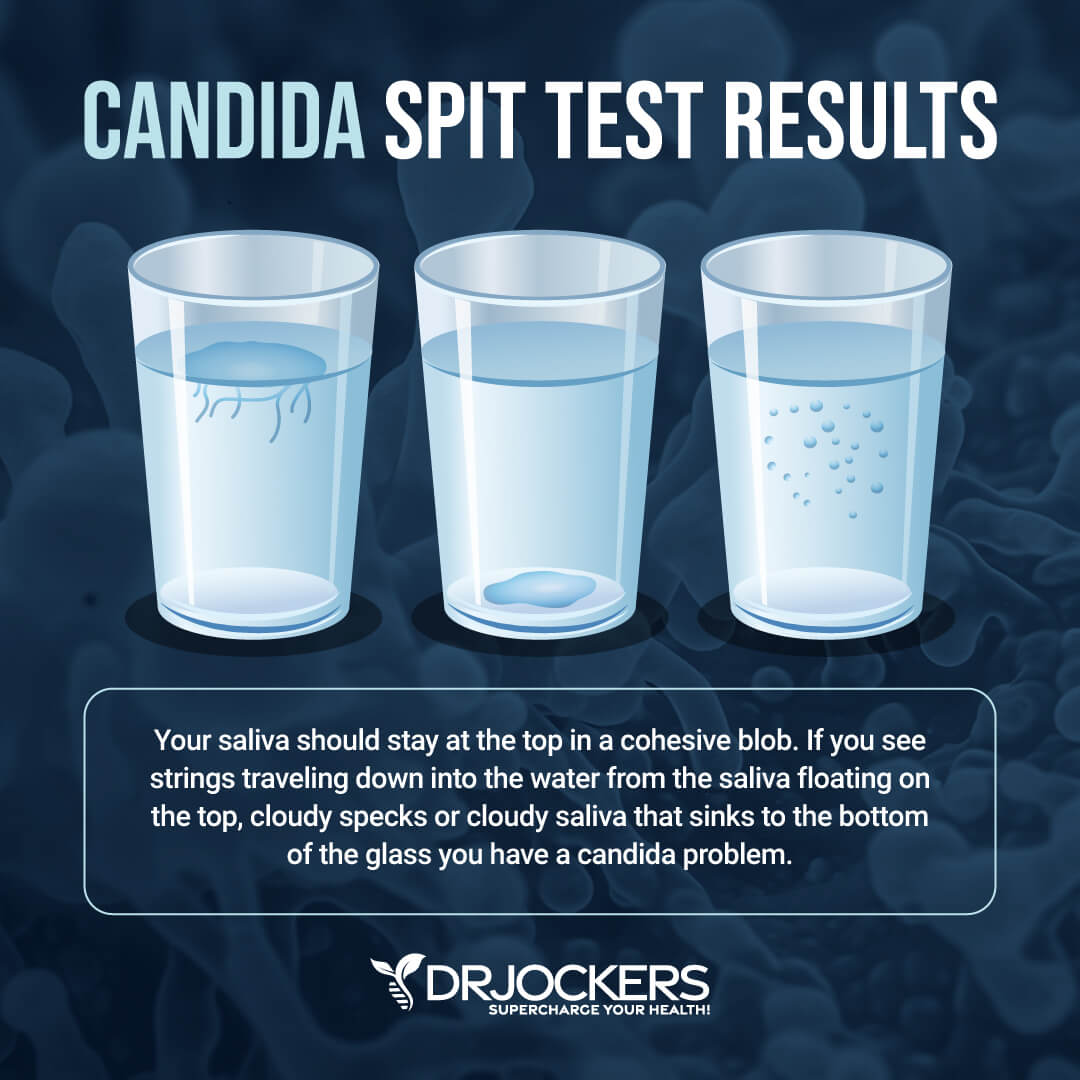 Best Home and Lab Tests for Candida Overgrowth in Your Body
Best Home and Lab Tests for Candida Overgrowth in Your Body
You may be surprised to learn that a fungus called Candida is normally present within your body. Candida is a yeast and is typically found in small amounts on the skin, in the mouth, and in the gastrointestinal tract. At normal levels, Candida is not problematic. However, when Candida overgrowth occurs, it leads to numerous health problems.
Digestive issues, fatigue, brain fog, recurring fungal infections, skin problems, mood swings, and many more health issues can be caused by Candida overgrowth.
It is important to test for Candida to determine whether a Candida overgrowth is an underlying cause of your health problems. Testing also enables your practitioner to devise the best treatment plan. In this article we will discuss the best testing options.

Candida Overgrowth Testing Overview
There are several tests that can help determine whether you have Candida, the level of Candida, and the type. There are at home testing methods that may indicate an overgrowth of Candida such as the Candida Questionnaire and the Spit Test.
For more accurate and definitive testing, the Comprehensive Organic Acids test, the GI-MAP, the Digestive Health Panel, and the Food Sensitivity with Candida tests are available. This article will describe Candida and discuss the symptoms and health issues associated with Candida. If you feel like this is something that could be affecting your health, testing is certainly the next step.

What is Candida?
Candida is a fungus, which is a form of yeast. It is normal, and even beneficial, to have small amounts of Candida.
Your immune system and the healthy bacteria in your gut normally keep your levels low. However, when Candida overgrows in the body, numerous health issues can result.
A Candida overgrowth can cause an infection called Candidiasis. There are several types of candidiasis including thrush (from Candida in the mouth and throat), genital yeast infection, a diaper rash from yeast infection, and invasive candidiasis. Invasive candidiasis is a serious life-threatening infection that occurs when Candida enters the bloodstream and travel to the heart, brain, eyes and bones.

Areas Affected by Candida Overgrowth
There are over 20 species of Candida that can cause infections. The most common is Candida albicans. Candida albicans are found in the mouth, intestinal tract, and vagina.
There are numerous factors that can cause an overgrowth of Candida. A diet high in processed foods, refined carbohydrates and sugar and the consumption of alcohol can cause candida to overproduce in the body.
Taking prescription hormones such as oral contraceptives and antibiotics can contribute to candida. Another contributor to Candida overgrowth is a high-stress lifestyle. It is important to take steps to address these contributing factors.

Symptoms and Health Problems
There are many symptoms associated with an overgrowth of Candida. Skin conditions such eczema, psoriasis, hives, rashes, athlete’s foot, or toenail fungus are common symptoms of Candida overgrowth. Vaginal infections, urinary tract infections, rectal or vaginal itching can also be caused by Candida.
One of the most common symptoms of Candida is fatigue. Candida can contribute to fatigue in various ways. Candida is often associated with nutrient deficiencies and a weakened immune system (1). Many people with Candida suffer from chronic fatigue or fibromyalgia.
Candida in the digestive tract aids with nutrient absorption and digestion. However, with candida overgrowth, it can cause leaky gut syndrome (intestinal permeability). Leaky gut syndrome is a gastrointestinal disorder that occurs when holes develop in the lining of the gastrointestinal tract. These holes allow harmful substances to pass through the gut wall and into the bloodstream.

Other Health Problems
Digestive issues such as bloating, constipation or diarrhea can indicate an overgrowth of Candida. In fact, recent studies show that an overgrowth of Candida is associated with several diseases of the gastrointestinal tract, including ulcerative colitis and Crohn’s disease (2).
Candida can also affect the brain causing irritability, mood swings, anxiety or depression. Other neurological symptoms are difficulty concentrating, poor memory, lack of focus, ADD, ADHD, and brain fog. Strong sugar and refined carbohydrate cravings are common with a Candida overgrowth as are severe seasonal allergies or itchy ears.
Candida can contribute to systemic inflammatory and immune-related conditions. Candida naturally produces and emits toxins into the blood stream and body. The body reacts with an immune response causing higher levels of inflammation.

Candida & the Liver
High levels of Candida can also affect the liver’s ability to detoxify the various toxins. This can result in whole body toxicity and immune dysregulation and leads to high levels of inflammation and possible autoimmune and cancer development. Autoimmune diseases such as Hashimoto’s thyroiditis, rheumatoid arthritis, ulcerative colitis, lupus, psoriasis, scleroderma and multiple sclerosis can be related to Candida overgrowth.
There are five crucial steps to heal Candida naturally. These steps include nutrition, anti-microbial support, improving liver function, strengthening the immune system, and restoring the gut lining.

Lab Testing for Candida
It is critical to test for Candida so that you can take measures to reduce an overgrowth in the body. The best lab tests for Candida are the Comprehensive Organic Acids Test, the GI-MAP, the Digestive Health Panel, and the Great Plains Food Sensitivity Test.
The Candida Questionnaire and the Spit Test are at home testing methods that may indicate an overgrowth of Candida.

Comprehensive Organic Acids Test
Organic acids are chemical compounds excreted in our urine. Organic acids in urine are often present at 100 times their concentration in the blood so they are more easily detectable in the urine.
The Organic Acids Test (OAT) by Great Plains Laboratory is a reliable and accurate test for various fungal toxins, including specific markers for Candida. While many labs have an organic acids test, the Great Plains OAT has more Candida markers. The OAT looks at 9 yeast and fungal markers including Citramalic, 5-Hydroxymethyl-2-furoic, 3-Oxoglutaric, Furan-2,5-dicarboxylic, Furancarbonylglycine, Tartaric, Arabinose, Carboxycitric, and Tricarballylic.
The Great Plains Comprehensive OAT is an amazing test offering an extensive metabolic snapshot of a person’s overall health. The test includes over 70 markers. In addition to yeast and fungal markers, the OAT has markers for bacteria, oxalates, mitochondria, ketone and fatty acid oxidation, vitamin and mineral levels, Kreb’s cycle (energy production), oxidative stress, and neurotransmitter levels.
Organic Acids Test is one of my favorite tests because of the amount of information it gives and the fact that it is a non-invasive urine test which can be done at home. For more information on the Comprehensive OAT, look here.
 GI-MAP™ DNA Stool Analysis
GI-MAP™ DNA Stool Analysis
The GI-MAP is the most thorough stool test on the market. It is a comprehensive stool analysis that identifies the presence of multiple pathogenic microorganisms. Not only will the GI-MAP detect Candida, it also shows other fungi, parasites (both protozoa and worms), and opportunistic bacteria.
The GI-MAP is the only FDA-approved DNA test for gastrointestinal microbes and pathogens available. The GI Map also tests for H. pylori, viral pathogens, levels of normal bacteria, potential autoimmune triggers, and viruses, including the cytomegalovirus and Epstein Barr virus. The GI Map reveals the health of your intestines with digestion, gastrointestinal, Secretory and Anti-gliadin IgA (immune response), and calprotectin (inflammation) markers.
Another great thing about the GI Map is that the test gives actionable biomarkers. The GI Map looks at all the major factors that can influence the health of the gut and what compounds will work best to eliminate the various pathogens. For more information on the GI Map and a sample report, you can look here.
 Digestive Health Panel
Digestive Health Panel
Stool testing is one of the most accurate tests available for Candida because it examines whether there is Candida in the colon or lower intestines. A comprehensive stool test can analyze levels of yeast, the species of yeast, and which treatment will be effective.
The Digestive Health panel tests for 48 possible yeast and fungal species. It also tests for pathogenic and beneficial bacteria, possible parasites, digestion and absorption markers, inflammation markers, intestinal immune function, inflammation markers, and overall intestinal health markers.
This Panel examines both cultured and microscopic yeast for accuracy. Yeast may appear cultured but not microscopically or vice versa. This is because yeast is not uniformly dispersed through the stool. A cultured amount of yeast may be detected while undetectable or low levels of yeast are identified by microscopic examination. Conversely, no yeast may be cultured while a significant amount of yeast may be revealed by microscope.
The Digestive Health Panel also reveals yeast susceptibility to various antimicrobials. This information allows your practitioner to devise an effective treatment plan for eliminating the yeast. To order the Digestive Health Panel, go here.
 Great Plains Food Sensitivity Test with Candida
Great Plains Food Sensitivity Test with Candida
Blood tests can check for IgG, IgA, and IgM Candida antibodies in your blood. High levels of these antibodies indicate that your immune system is reacting to the presence of Candida in the body.
The Great Plains IgG Food Sensitivity Test with Candida measures Immunoglobulin G (IgG). IgG is the largest circulating antibody in the body and is found in all bodily fluids. IgG is produced by the immune system to keep our bodies healthy when antigens (foreign substances such as viruses) enter the body. Measuring IgG levels can give us a better understanding of our immune response to Candida.
The Great Plains IgG Food Sensitivity Test with Candida is a dried blood spot test that can be collected from the convenience of home. It measures your immune response to 93 commonly consumed foods as well as how the body is tolerating the Candida that is present in your body. It is important to remember that Candida can suppress the immune system, so you may not produce an immune response to Candida. In that case, a negative IgG test for Candida can be a false negative.
Candida antibodies may trigger autoimmune diseases and react with virtually all human organs. Candida antibodies are elevated in Crohn’s disease, cystic fibrosis, and cancer. Testing for Candida antibodies can help you determine whether you have an overgrowth of Candida. You can find this test here.
At Home Testing for Candida
While not as reliable and accurate as lab testing, there are at home methods of testing for Candida overgrowth. The Candida Questionnaire and the Spit Test are two ways to identify whether Candida may be an issue for you.
Candida Questionnaire
The Candida questionnaire was developed by Dr. William Crook. Dr. Crook is one of the original pioneers who brought the issue of yeast overgrowth to awareness. This questionnaire helps identify the risk factors for Candida.
Dr. Crook’s Candida Questionnaire:
| QUESTION | YES | NO |
| 1. Have you taken repeated or prolonged courses of antibacterial drugs? | 4 | 0 |
| 2. Have you been bothered by recurrent vaginal, prostate or urinary infections? | 3 | 0 |
| 3. Do you feel “sick all over,” yet the cause hasn’t been found? | 2 | 0 |
| 4. Are you bothered by hormone disturbances, including PMS, menstrual irregularities, sexual dysfunction, sugar craving, low body temperature or fatigue? | 2 | 0 |
| 5. Are you unusually sensitive to tobacco smoke, perfumes, colognes and other chemical odors? | 2 | 0 |
| 6. Are you bothered by memory or concentration problems? Do you sometimes feel “spaced out”? | 2 | 0 |
| 7. Have you taken prolonged courses of prednisone or other steroids; or have you taken “the pill” for more than 3 years? | 2 | 0 |
| 8. Do some foods disagree with you or trigger your symptoms? | 1 | 0 |
| 9. Do you suffer with constipation, diarrhea, bloating or abdominal pain? | 1 | 0 |
| 10. Does your skin itch, tingle or burn; or is it unusually dry; or are you bothered by rashes? | 1 | 0 |
| 11. When you wake up, do you have a white coating on your tongue? | 1 | 0 |

Spit Test
The spit test for Candida is done by collecting saliva in your mouth and spitting into a clear glass of water. This is done as soon as you wake up in the morning before you put anything in your mouth. You watch the saliva in the glass for 15 minutes. If you observe any of the following about your saliva it may indicate the presence of Candida:
- Stays at the top and you see thin strands that look like strings or spider legs extending downward.
- Floats to the bottom and looks cloudy.
- Suspended in the water and looks like little specs are floating.
The spit test may not be very reliable. The test has a high rate of false negatives and false positives. The test is assessing how thick your mucus is in the morning. Spit is usually thicker in the morning due to the effects of not drinking all night.
Other factors that can affect the thickness of mucus include consumption of dairy products, changes in the weather, airborne allergies, and other infections. Results can also be inconsistent from day to day with the same individual. If your spit test is positive, you should confirm the results with a lab test.

Conclusion
Candida is a yeast naturally found in the gut. A healthy microbiome will keep opportunistic Candida in check. When the microbiome is thrown out of balance, Candida can quickly spread throughout the body. This leads to numerous health issues and leaky gut.
It is important to test for Candida to determine if you have an overgrowth. There are numerous lab tests for Candida including the Comprehensive Organic Acids Test, the GI-MAP, the Great Plans Comprehensive Stool Analysis, and the Great Plains IgG Food Sensitivity with Candida test. There are two at-home methods that may indicate an overgrowth of Candida, the Candida Questionnaire and the Spit Test. These at home methods are not as reliable and should be confirmed with a lab test.
For more information on the 5 step process to beat Candida naturally, check out this article here.

Inflammation Crushing Ebundle
The Inflammation Crushing Ebundle is designed to help you improve your brain, liver, immune system and discover the healing strategies, foods and recipes to burn fat, reduce inflammation and Thrive in Life!
As a doctor of natural medicine, I have spent the past 20 years studying the best healing strategies and worked with hundreds of coaching clients, helping them overcome chronic health conditions and optimize their overall health.
In our Inflammation Crushing Ebundle, I have put together my very best strategies to reduce inflammation and optimize your healing potential. Take a look at what you will get inside these valuable guides below!





It has taken me almost 2 years now to heal my leaky gut and Candida overgrowth. I am 100% better and my visits with my Dr are spaced way out, thank goodness. I know that you recommended a Soil based probiotic and I have always wondered if I should be taking that instead of the live probiotics that I’ve taken all along. Should I switch to the soil based all together? Or should I take both? I’ve asked my Dr this before, but I didn’t really get a clear answer. Thank you so much for these articles. You’ve helped me so much and so many others.
It is a good idea to cycle between the two every 3-6 months!
Dr. JOCKERS
Your articles are KNOWLEDGEABLE! my comment for Candida (Super
Strength Oil of Oregano seven (7) drops “MUST” go under the tongue
for Leaky Gut (Pine Nut Oil) . I’m a Health Nut!
Those can be helpful Judy!
Hi. I know I have candida. I taken natural anti-fungals and prescription anti-fungals. I have been on a strict diet for years, but I still have a problem with candida. It seems like the anti-fungals are no longer working. What do you do when they don’t? I don’t know what else to do. Thank you for taking the time to read this.